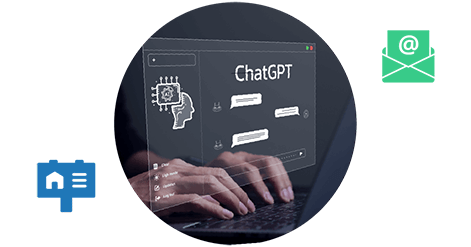How to Use Direct Mail Postcards to Create Inspiring Campaigns

In today's digital age, it's easy to forget the power of tangible marketing materials in connecting with and inspiring your audience.
Direct mail postcards are a tried-and-true method that continues to make an impact, even in a digital-first economy. In this blog, we'll dive deeper into Direct Mail Postcards, how to properly create them, and how they can be used to create incredible hyperlocal lead generation campaigns.
Let's get started.
Understanding Direct Mail Postcards
Designing Your Direct Mail Postcards
Crafting Compelling Content for Your Direct Mail Postcard
Implementing Your Direct Mail Postcard Campaign
Understanding Direct Mail Postcards
What Are Direct Mail Postcards?
Direct mail postcards are promotional print materials sent to a targeted group of recipients via postal mail.
They are a powerful marketing tool designed to inspire action from the recipients by showcasing a company's products, services, or special offers visually appealing and concisely.
The effectiveness of direct mail postcards lies in their ability to grab attention, convey a message efficiently, and prompt recipients to take the desired action.
These postcards can range from simple, eye-catching designs focusing on a single, bold message to highly personalized messages considering the recipient's needs and preferences.
By leveraging the power of direct mail, marketers can reach their target audience more intimately and tangibly, creating a stronger connection compared to some digital marketing channels.
Direct mail postcards are effective when well-crafted, combining compelling visuals with clear and engaging messaging. They should stand out in the recipient's mailbox, ensuring your message isn't lost among other mail.
Benefits of Direct Mail Postcard Campaigns
Higher response rates: According to the Direct Marketing Association (DMA), direct mail postcards have a response rate of 4.9% for prospect lists and 9.0% for house lists. That's impressive compared to the average response rate of 0.6% for email marketing.
Tangibility: Direct mail postcards provide a physical touchpoint with your audience, which can help create a stronger connection and sense of trust.
Targeted outreach: With PropertyRadar's hyperlocal lead generation software, you can pinpoint the exact demographic you want to reach, ensuring your postcards get into the hands of those most likely to be interested in your offerings.
Easy to track: Direct mail postcards can be tracked using unique URLs, promo codes, or even QR codes, making it simple to measure the success of your campaign.
Cost-effective: While the cost per piece might be higher than digital marketing, the higher response rates often make direct mail postcards a more cost-effective choice in the long run.
Types of Direct Mail Postcards
Standard postcards: Your basic, no-frills postcards feature an attention-grabbing design and a clear call to action. They're ideal for brand awareness and simple promotions.
Oversized postcards: Want to make a statement? Try an oversized postcard. These larger format cards offer more real estate for eye-catching visuals and are harder to miss in a recipient's mailbox.
Personalized postcards: Amp up your game by sending personalized postcards that speak directly to your audience's needs and preferences. You can use data from PropertyRada to customize your message based on location, property information, and more.
Every Door Direct Mail (EDDM) postcards: These are designed to be sent to every address in a specific geographic area, making them perfect for local businesses or event promotions.
Specialty postcards: Stand out from the crowd with specialty postcards that incorporate unique elements like die-cuts, embossing, or even scratch-off sections to pique interest and encourage engagement.
Designing Your Direct Mail Postcard
The thing about creating an inspiring campaign? It's crucial to have a well-designed direct mail postcard to capture the attention of your target audience and inspire them to take action.
In this section, we'll discuss the importance of design and share some tips and best practices to help you create a postcard that stands out in the mailboxes of potential clients, such as homeowners and property managers.
The Importance of Design
The design of your direct mail postcard is vital because it creates the first impression of your business in the minds of your potential clients.
An effective design not only captures attention but also conveys your brand's message and values in a visually appealing way. A well-crafted postcard design can help you stand out from the competition and increase the likelihood of your audience engaging with your services.
Design Tips and Best Practices
Creating an engaging design and successful direct mail postcard comes down to the following design elements:
Layout and Composition: Organize the elements of your postcard in a way that leads the recipient's eye through the design, ensuring that your main message and call-to-action (CTA) are the focal points.
Use white space strategically to avoid clutter and make your postcard easy to read.
Color Scheme and Imagery: Choose a color scheme that reflects your brand identity and appeals to your target audience. Use high-quality images relevant to your business, such as photos of completed projects or satisfied customers.
Remember to keep the images in line with your brand and the services you offer unless you intend to run an intentional off-brand campaign.
Typography and Text Placement: Select fonts that are easy to read and complement your brand's style. Limit the number of fonts used to maintain a clean and cohesive look.
Place text in a way that doesn't distract from the main message and CTA, and keep the copy concise to ensure your message is quickly and effectively communicated.
Creative Design Ideas and Examples
When designing a direct mail postcard campaign, you'll want to do everything possible to avoid blending in, ensuring you stand out. Here are a few ideas and examples to spark inspiration:
Showcase your work: Include high-quality images of your completed projects, such as a transformed landscape, a newly installed roof, or a plumbing repair. Before-and-after photos can be particularly effective in demonstrating the value you provide.
Use customer testimonials: Incorporate quotes from satisfied clients to add credibility and trustworthiness to your business. You can combine this with images of the completed work to create a powerful visual and emotional impact.
Offer a limited-time promotion: Create a sense of urgency with a special offer or discount available for a limited time. This encourages recipients to take immediate action and engage with your services.
Incorporate a seasonal theme: Design your postcard around a specific season, such as offering spring landscaping services or winter plumbing maintenance tips. This makes your postcard timely and relevant.
Play with shapes and textures: Think beyond the traditional rectangular postcard. Experiment with die-cut shapes, embossing, or textured paper to create a tactile experience that stands out in a recipient's mailbox.
Direct Mail Postcard Sizes
Selecting the right postcard size is crucial for maximizing your message's impact and ensuring it meets postal requirements. The most common direct mail postcard sizes include:
Standard (4" x 6" ): This size is cost-effective and meets the USPS First-Class postcard rate requirements. It's ideal for simple promotions and brand awareness campaigns.
Large (5" x 7" or 5.5" x 8.5 "): These larger postcards offer more space for visuals and text, making them an excellent option for showcasing your work or providing more detailed information.
Oversized (6" x 9" or 6" x 11 "): Oversized postcards are more likely to capture attention in a crowded mailbox and provide ample room for stunning visuals and impactful messaging.
Before launching any design work, check USPS requirements and postage rates for your chosen size to ensure your postcards are delivered efficiently and cost-effectively.
Utilizing Direct Mail Postcard Templates
When using direct mail postcard templates, keep these friendly dos and don'ts in mind to create an awesome and professional-looking design:
When using Direct Mail Postcard Templates, Do:
Give the template your personal touch: Mix the color scheme, fonts, and images to match your brand's vibe and create a cohesive look that screams "you."
Keep your message and CTA crystal clear: Make sure your main message and call-to-action (CTA) stand out and are super easy to understand, even when working with the template's layout.
Show off with high-quality images: Ditch any stock images and replace them with stunning photos showcasing your work, making the postcard feel more genuine and unique.
When Using Direct Mail Postcard Templates, Don't:
Stick to the template's defaults: Simply going with the template's basic settings may result in a cookie-cutter look that doesn't do your business justice or catch the eye of your target audience.
Cram the layout with too much text or info: Stuffing the template with content can make it look cluttered and overwhelming, so keep it simple and focused on what matters most.
Crafting Compelling Content for Your Direct Mail Postcard
Creating an effective direct mail postcard for your business requires a visually appealing design and compelling content that resonates with your target audience.
In this section, we'll explore the power of messaging, share tips for writing engaging content, discuss the importance of calls to action (CTAs), and provide content examples to inspire your postcard campaign.
The Power of Messaging
The message you convey in your direct mail postcard is crucial in determining its success. A well-crafted message can pique the interest of potential clients, demonstrate the value of your services, and prompt recipients to take action.
Understanding your target audience and tailoring your messaging to their needs and preferences can create a more personalized and effective marketing campaign, both of which are qualities of a true hyperlocal effort.
Dos and Don'ts for Writing Engaging Content
To create engaging Direct Mail Postcard content, do:
Keep it short and sweet: With limited space on a postcard, focus on getting your message across quickly and efficiently. Use short, punchy sentences and ditch any unnecessary jargon.
Make it relevant to your audience: Speak directly to your target audience's needs, concerns, or pain points, like those of homeowners or property managers. Relevancy helps build a stronger connection and makes your message more relatable.
Flaunt your unique selling points (USPs): Clearly communicate what sets your business apart from the competition, whether it's your years of experience, exceptional customer service, or specialized expertise in a particular area.
Be neighborly: You don't want to rub someone the wrong way with overly-aggressive language that's threatening or too pushy. Keeping a helpful tone while convincing your audience you can solve their problem is a great way to get them to interact, whether it's contacting you for a quote or scheduling a service appointment.
To create engaging Direct Mail Postcard content, don't:
Be too wordy: Overloading your postcard with text can make it hard to read and less impactful, so keep things concise and to the point.
Ignore your audience's needs: Inadequately addressing your target audience's concerns or pain points can make your message less effective and less likely to resonate.
Hide your USPs: Don't be shy about showcasing what makes your business unique—let your potential clients know why they should choose you over the competition.
Forget to encourage action: Make sure to guide recipients towards a specific action, like getting in touch or booking a service, so they know what to do next.
Calls to Action (CTAs) in Direct Mail Postcards
A clear and compelling CTA guides recipients toward the desired action. Consider the following when crafting your CTA:
Make it visible: Ensure to prominently place your CTA and make it easily noticeable on your postcard.
Be specific: Clearly state the action you want the recipient to take, such as calling for a free estimate, visiting your website, or redeeming a coupon.
Create urgency: Encourage immediate action using time-sensitive language or offer a limited-time promotion.
Implementing Your Direct Mail Postcard Campaign
Now that you've designed and crafted the content for your direct mail postcard, it's time to put your campaign into action. In this section, we'll discuss launching your campaign, introduce Every Door Direct Mail (EDDM), and explore how to measure your campaign's success.
Launching Your Campaign
To launch your direct mail postcard campaign, you'll need to consider the following steps:
Creating a Mailing List: Compile a list of potential clients or properties you want to target. This could include specific neighborhoods, property types, or demographics that align with your business goals. Ensure your list is up-to-date and accurate to maximize your campaign's effectiveness.
Printing and Customizing Postcards: Work with a professional printer to produce high-quality postcards. Discuss customization options, such as paper stock, finishes, and coatings, to ensure your postcards look and feel professional. Remember to incorporate your branding elements and follow the design and content tips discussed earlier.
Understanding Pricing and Costs: Familiarize yourself with the costs associated with direct mail campaigns, including printing, postage, and mailing services. Compare pricing options and consider bulk discounts or promotional offers to make your campaign more cost-effective.
Every Door Direct Mail (EDDM)
Every Door Direct Mail (EDDM) is a USPS service that allows you to send your postcards to specific neighborhoods without needing individual addresses. This type of service can be beneficial for if you’re looking for a less-targeted way to reach out to local customers, but may not be recommended for most campaigns.
EDDM can save you time and money on mailing lists while still reaching a broad audience. However, you'll want to research EDDM guidelines and requirements to ensure your campaign runs smoothly.
Measuring Campaign Success
Tracking the performance of your direct mail postcard campaign is essential for determining its effectiveness and identifying areas for improvement. Consider these methods for measuring success:
Redemption tracking: Include unique codes, coupons, or QR codes on your postcards to track redemptions and gauge the campaign's response rate.
Call tracking: Set up a dedicated phone number for your campaign to monitor call volume and quality.
Online analytics: Use website analytics tools to track postcard-driven website visits, form submissions, or online bookings.
A/B testing: Test different postcard designs, offers, or messages to identify which elements resonate most with your audience.
Conclusion
To create a successful direct mail postcard campaign, remember these key takeaways:
- Direct mail postcards are versatile promotional materials that can be highly targeted and personalized to resonate with your audience.
- A well-designed postcard that combines engaging content, eye-catching visuals, and a clear call to action is crucial for driving engagement and inspiring action from recipients.
- Implement your campaign by carefully creating a mailing list, working with professional printers to customize postcards, and understanding direct mail marketing costs.
- Services like Every Door Direct Mail (EDDM) can help you reach a wider audience without needing individual addresses, making it a cost-effective and efficient option.
- Measuring the success of your campaign is essential for continuous improvement and optimization of your marketing strategy, enabling you to achieve better results over time.
Final note: When you're ready to dive into direct mail postcard marketing, take the time to research and compare different printing and mailing services that cater to your specific needs.
Look for providers with experience in your industry, customizable templates, and high-quality printing options to ensure your postcards look professional and stand out. Seek out competitive pricing and bulk discounts to maximize your marketing budget and generate a higher return on investment.


